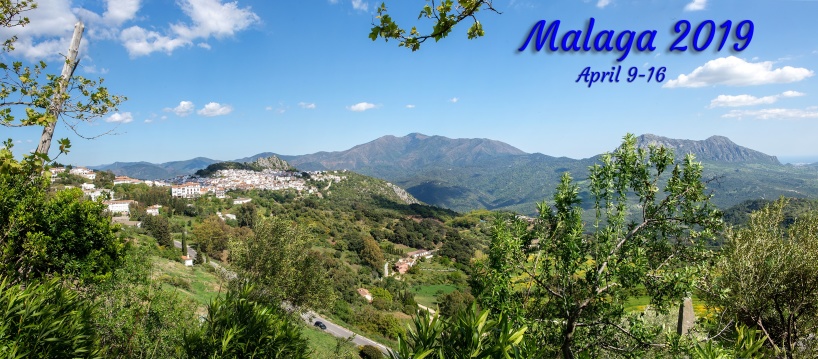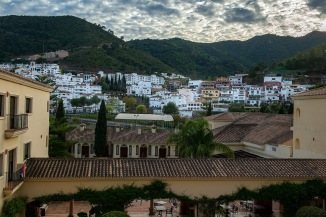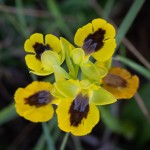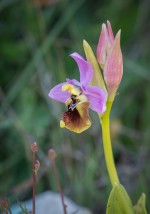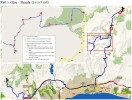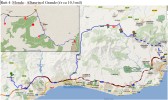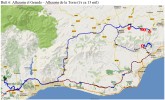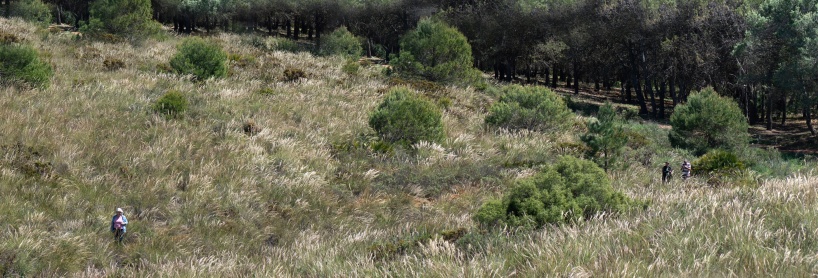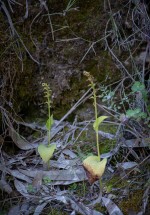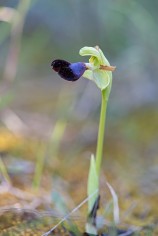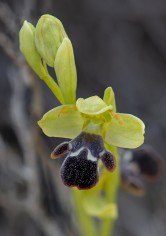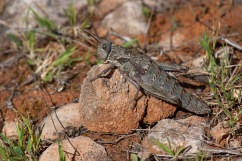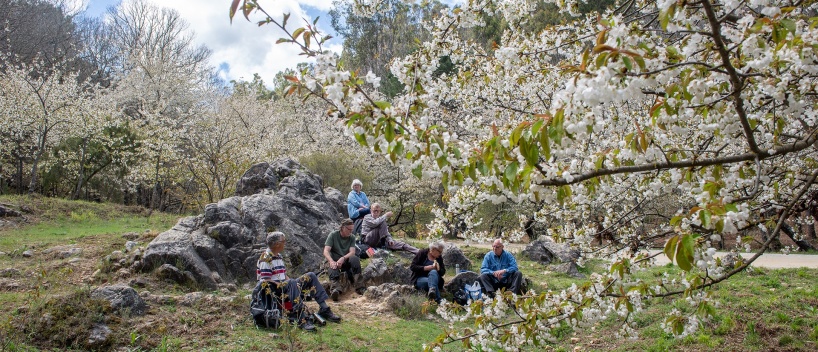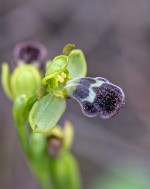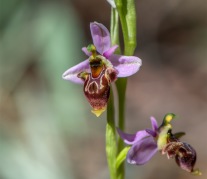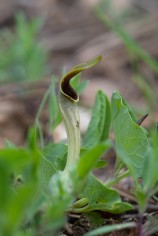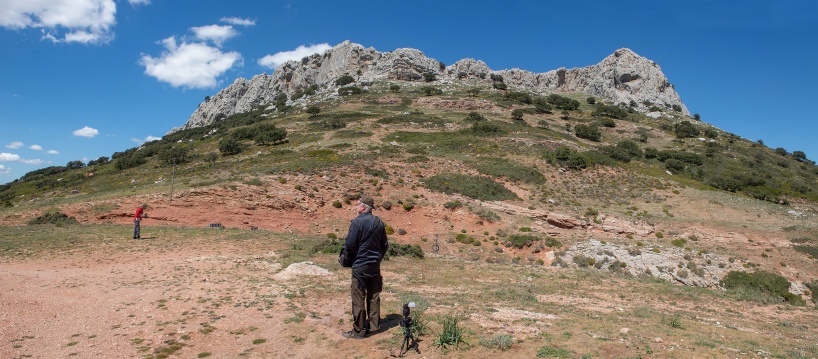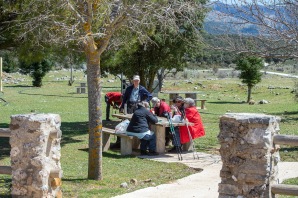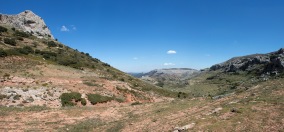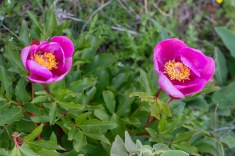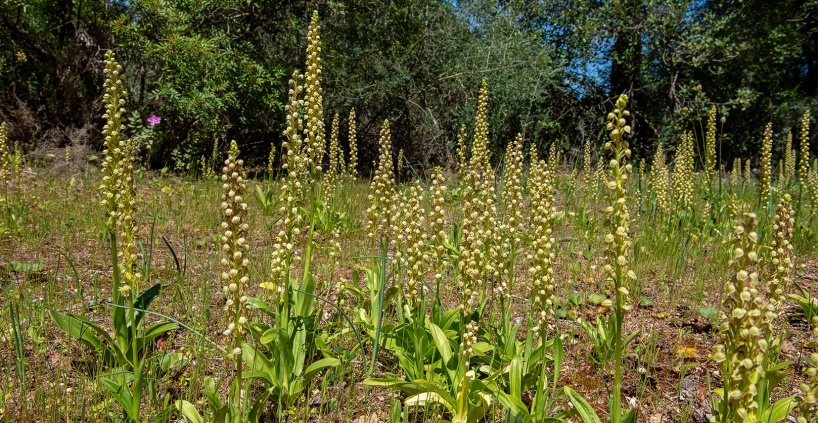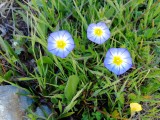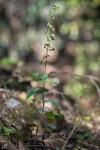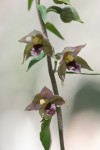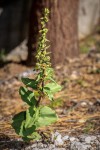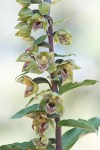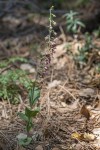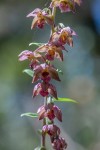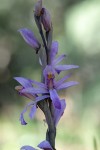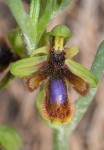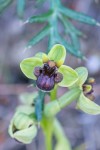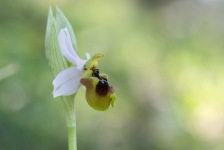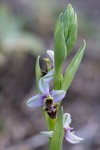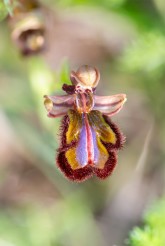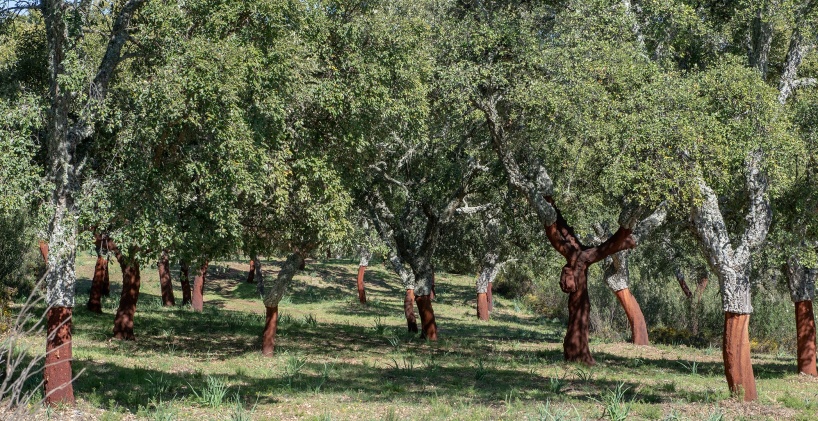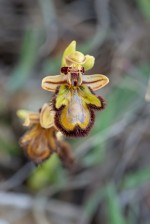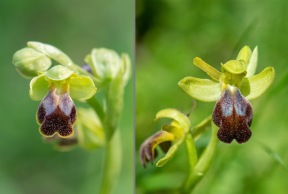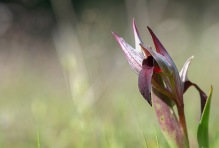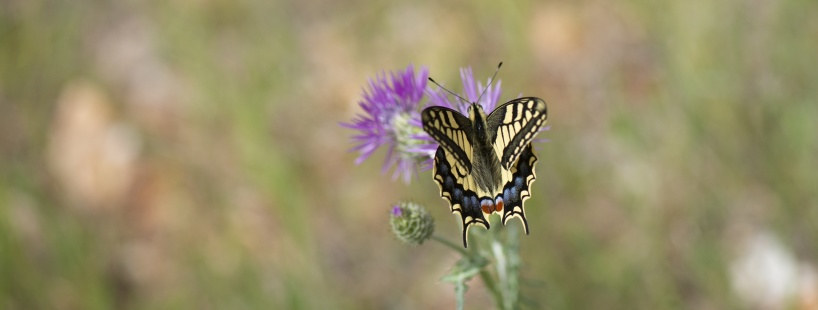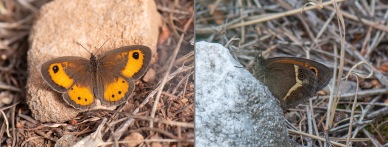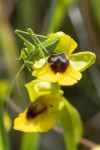Home | About Orchids | Orchid Areas | Galleries | Comments | Contact | Search
(By clicking the photos will give you a bigger picture)
A visit to the Province of Malaga, Andalusia 9-16 April 2019
Introduction
With the spring coming, the traditional orchid journey was again on the table. During the winter it had been decided and planned for a revisit to Spain. By and large the trip followed what we did six years ago, 2013, namely a return visit to the province of Malaga.
The trip went on between 9 and 16 April, which turned out to be an excellent choice. Only few days before our arrival the weather had been bad with both wind and rain. During our week, however, it turned out that we got typically nice Swedish summer weather with 18 - 24 degrees during the days and sun all the time.
We were 16 persons who were registered for the trip, two of whom were already in the area for playing golf but now they joined the group. Three persons chose to fly from Kastrup but since their plane arrived to Malaga almost at the same time as the flight from Gothenbourg, which the other 11 travelled from, it didn’t cause any problem. The flight time suite us well since we arrived to Malaga in the afternoon and, after picking up our rental cars, could be at the hotel at about 6 PM. A bit more inconvenient was the return journey since the plane would departure already at. 7:00 AM, which meant that we had to leave the hotel already at 3 o'clock at night.
As we did 2013, we had chosen to book hotel in the small town Benahavis, about 8 km from the sea, and this became base for our excursions. The hotel, The Gran Hotel & Spa, located on the outskirts of the town, and suited us well with nice rooms and good food in the restaurant, which some of us took advantage of the whole week.
Weather and conditions
Along the coast and the immediate surroundings, it looks that buildings, golf courses and other tourist facilities had increased since last time. But since we mostly moved inland, this was nothing that disturbed us, once we travelled a short distance from the coast; most things were like our last visit.
As mentioned above, we had fine summer weather all the time and no significant wind. From that point of view, our week was successful. However, the fields was very dry. The winter and spring had been very dry which affected the amount of flowering orchids. Most species were seen as few specimens, some as single plants. The only species that seemed to have passed the winter drought without harm was Ophrys lutea; this was seen at almost all sites visited, often in large numbers.
It is possibly that the dry, warm weather during the winter / spring had caused an early flowering, at least for some species. This time we were able to find species such as Ophrys speculum ssp. lusitanica, Ophrys tenthredinifera ssp. ficalhoana and Orchis langei, species that usually are flowering little later, and which we not found at our previous visit. Even some flowering Epipactis species were seen.
But at the same time, not many faded species were found other than those could be expected to be so, for example some Ophrys fusca-species that were seen, were completely dried or with large seed pods. Even Himantoglossum robertianum was only seen as faded specimens. One species that we only found once and also as faded were Neotinea conica.
Another factor that affected the amount of orchids, and which we noted at many of the visited sites, was the extensive digging of wild boar. Sites that at our last visit had plenty of orchids were now looking like potato fields. It is of course difficult to decide whether the lack of flowers was due to the wild boars digging or the drought, but our estimation was that in many places, there could not be many orchid tubers left after the wild boar's extensive diggings.
Excursions
During the week, six excursions were made. As usual, because of lack of time, we didn’t visit all planned sites. A selection was therefor made to secure that we reach the most interesting ones. The roads in this part of Spain are of good standard though, necessarily with regard to the landscape, winding and often narrow. Below is a summary per day of sites that were visited and what we saw. NOTE: The numbering of the sites in the summary are the numbers that were stated in the planned routes. NOTE: Route 5 was a reserve route that was not used.
Route 1 Route 2 Route 3 Route 4 Route 6 Route 7
Route 4 was one of the shorter ones during our trip and therefore a suitable route for our first day that traditionally started somewhat later than the following days. The route had four planned sites, which we also visited. It largely went through lowlands, at about 300 m level, which was another reason for starting the week with this one.
We started by driving down to the A7 which we followed until exit 185 towards Ojén, and road A-355. We than followed A-355, passed Ojén and further on also Monda. The sites were visited in the same order as planned.
Our way back home went down to the town of Mijas and further down to the A7 which we followed back to the hotel.
Site 1 - Limestone quarry
About 5 km after passing Monda we turned right into road A-7102 towards Coin, but immediately after the exit we turned right again, at the first crossing (Coin to the left) and then drove about 1 km through a limestone quarry. Directly after the fence around the quarry ended, there was a hillock to the left with some pine trees and sparse bush vegetation. Just like last time, the sought-after Gennaria diphylla stood right in front of the cars, but this time almost faded. Otherwise, we already here could see, what we later would be very well aware of, that the fields were very dry and few orchids to find compared to our previous visit.
Orchids:
Gennaria diphylla Ophrys speculum
Ophrys lutea Orchis italica
Gennaria diphylla was clearly passed its best.
Site 1.5, A-355 next exit
We then continued back to A355 and followed this about 1 km to the next exit marked "Camino de Los Llanos". After the exit we directly turned right and drove not more than 100 m, here we met another road. This was site 1.5. Two power lines crossed the area and beneath these the forest was cleared. Otherwise, the area consisted of sparse coniferous forest. Most interesting was the open terrain under the larger power line.
Orchids:
Neotinea maculata Ophrys tenthredinifera
Ophrys atlantica Ophrys fusca sp (faded)
Ophrys lutea Serapias lingua
Ophrys speculum Serapias lingua? (hybrid??)
Ophrys atlantica
Site 2, Urique
We continued A-355 about 2.7 km and at the junction towards Coin (center) we turned right onto road MA-3303 towards Mijas. After about 1.5 km we passed the village of Urique but continued for another 0.8 km. Site 2 is the area along the path to the right. The open area to the right of this was covered with dry, tall, hard grassy tufts with only small areas where other herbs could grow. At the other side of the path, wild boar had thoroughly plowed up the forest floor. This area had, at our previous visit, lot of orchids and other flowers. Now nothing.
Orchids:
Anacamptis papilionacea Ophrys lutea
Ophrys algarvensis Ophrys speculum
Ophrys tenthredinifera
One of Malaga's rarity - Ophrys algarvensis
Site 3, Opposite Golf Club Puerto de Pescadores
After site 2 we continued MA-3303 and after about 3.3 km we took the second exit at the roundabout into road A-387. But already after about 250 m, there was a path to the left up through a weak slope with pine forest, under a power line. Here we had our site 3 (today's fourth site).
This was perhaps one of the sites where the drought had made most changes compared to 2013. Almost no orchids were found here.
The biggest gain from this site was perhaps the huge grasshopper, about 10 cm, a nymph that not yet had developed wings (species?).
Orchids:
Ophrys scolopax (faded) Ophrys speculum
As mentioned above, our way back home went to the village of Mijas and further down to A7 which we followed back to the hotel.
Lunch break in a cherry grove at Refugio De Juanar
Now we drove up into the mountains behind the tourist town of Marbella. The road went on between the Sierra Blanca massif to the west and the Sierra Alpujata to the east until we reached the 800 m level.
From our hotel we drove down to the AP-7 and followed this until exit 185 and turned into road A355, i.e. the same way as day one, but now we turned off before we reached Monda. About 4.5 km after passed Ojén we turned left into road 3300 towards Refugio De Juanar.
We searched five of the six sites that were along this route (we didn’t find parking for four cars at the third site so it was just to pass by).
The last site of the day was just after we returned back to A-355, direction Monda. Here we turned around and drove back same way as we came.
Site 1, 1 km from A-355
After turning left onto road 3300 we drove to the Km 1 sign where it was possible to park the cars roadside. Site 1 was down the slope to the right of the road, sparse forest with some bushes.
Here too there had been a lot of wild boar but we managed to find some specimens of the sought-after Ophrys dyris.
Orchids:
Anacamptis champagneuxii Ophrys dyris
Neotinea maculata Orchis anthropophora (many)
Ophrys dyris, yet another of Malaga's rarities
Site 1.5, At KM 2
The next stop was made at the Km 2 sign one km further on. Here we searched both sides of the road a few hundred meters forward and backwards..
Orchids:
Neotinea maculata Ophrys tenthredinifera
Ophrys fusca sp., lupercalis? (faded) Orchis anthropophora
Ophrys scolopax
Ophrys scolopax
Lokal 2, Small, white house
Near the road up to the houses at Refugio there is a small white house to the left. Site 2 is the rocky, bushy and steep slope before and after the house.
Himantoglossum grew on the roadside to the right just before the house.
Orchids:
Anacamptis sp (only leavs) Orchis anthropophora
Himantoglossum hircinum (bud) Orchis mascula (??)
Ophrys scolopax Orchis olbiensis
Himantoglossum hircinum
Site 3, Along the road that past the hotel
Here we started with our lunch, sitting in a cherry grove in full bloom, perhaps the most beautiful lunch stop of the whole journey. We then botanized along the road up to the buildings and beyond. In addition to being steep, the slopes were largely covered by impenetrable blackberries. A large number of leaf rosettes were seen, both with and without markings (dots), probably Orchis langei. In any case one such was seen with almost open buds.
Orchids:
Cephalanthera longifolia
Himatoglossum hircinum (leavs)
Ophrys scolopax
Orchis langei
Other findings here were Aristolochia pistolochia
Site 5, A-355 toward Monda, at restaurant Venta Pula
As the last site before we returned home, we searched site 5. This was just after that we returned to A-355, at a tavern. It looked like there was also some kind of leisure area with sparse pine forest. We explored the areas on both sides of the main road. In the 1 m wide grass strip between the parking area and the slope down to the main road, an O. picta grew among lots of O. speculum, all lush and fresh, and next to those was a large colony O. lutea, equally fine. Theory: The large paved parking area has received the rain that nevertheless come, which then flow down along the slightly sloping surface and favored the grass strip which looked quite different from the vegetation on the crunchy dry ground around.
a) From the restaurant's parking up to the brook ravine further back.
Orchids:
Anacamptis champigneuxii Ophrys picta
Neotinea maculata Ophrys speculum
Ophrys lutea Ophrys tenthredinifera
Ophrys fusca sp.
b) Other side of the main road (A-355).
Orchids:
Neotinea maculata Ophrys speculum
Ophrys lutea Ophrys tenthredinifera
This became, as mentioned above, the last site before we returned home same route as we came earlier.
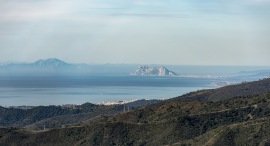 The road to Ronda offered many spectacular views. Here toward Gibraltar and The Atlas Mountains in North Africa
The road to Ronda offered many spectacular views. Here toward Gibraltar and The Atlas Mountains in North Africa
This route went on up to the Serrania de Ronda mountain range and the Sierras de Las Nieves nature conservation area. We started driving towards the coast but then turned left and drove through the "golf areas" and the luxury residential quarters before we turned north and started climbing upwards. We followed road A-397 up to Ronda but first we visited the nature conservation area Sierras de Las Nieves. A-397 passes on the edge of this. After searching in sites 1-3, we reached the outskirts of Ronda where we turned right into road A-366 and drove east towards El Burgo. Now we were in the mountain massif Serrania de Ronda and the road slowly went up to almost 1,200 m level. After site 7 we choose to return back to Benahavis same way as we came during the day.
Site 1, Entrance to the Sierras de Las Nieves
About 38.5 km from the hotel, there is a path (narrow road) into the Sierras de Las Nieves. Big signs mean we couldn't miss the entrance. After about 200 m along the road there was a large parking- / picknic area. Site 1 was the area around this. It turned out that the area was heavily grazed and also very dry. It was therefore very few orchids compared to last time.
Orchids:
Ophrys lutea Orchis anthropophora
Ophrys champagneuxii Orchis olbiensis
Ophrys speculum Orchis olbiensis, vit
Site 2, Sierras de Las Nieves, the road further on
About half a kilometer further on, the asphalt road ended and here we had the next stop. Site 2 was the areas on both sides of the road further ahead. Low forest and shrubs.
Quantities of small peonies were seen at the right side of the road, but only leavs; probably two species Paeonia broteroi and perhaps P. mascula?
Orchids:
Anacamptis champigneuxii
Ophrys tenthredinifera
Orchis olbiensis (many color forms)
Color forms of Orchis olbiensis
Site 3, Graveled road further on
Another few hundred meters ahead, a new stop was done. Same type of landscape as the 2nd but the bush vegetation was very thick here. At a few meters wide area on both sides along the road, the bushes have been cleared and here there should be nice areas for orchids, though not this year.
We turned here and drove back to A-397.
Orchids:
Cephalanthera longifolia Anacamptis champigneuxii (very small )
Site 5, Road A-366 Ronda-El Burgo, highest point, Puerto del Viento
About 700-800 m further on, a path went to the left and here we could park the cars. Site 6 was the slopes to the right of the road. Low vegetation, but few orchids. However, we found some magnificent blooming peonies, Paeonia broteroi, and a lot of low-growing Ornithogalum collinum.
Other interesting things were cornish chough and blue rock thrush.
Orchids:
Ophrys lutea
Paeonia broteroi
Site 7, Big sign "Sierra de Las Nieves" (El Burgo)
From site 6 we continued about 3 km. Here the next stop was done, at a large "Sierra de Las Nieves" sign to the right. The site was the slope to the right of the road, between the road and a fence higher up. Rocky, somewhat rugged terrain. But a nice slope with cranesbill, ranunculus, blue scillas, and a single, still flowering, mini daffodil (Narcissus baeticus). Woodlark and cuckoo were heard.
Orchids:
Ophrys lutea
Ophrys tenthredenifera
Orchis olbiensis, 100-tals
This was the end of the day and we chose to drive same way back to our hotel.
Ophrys lutea
Man orchid - Orchis anthropophora at site 3b
Once again we drove down to the A7 but this time we turned right and drove westward. At Manilva we left the highway (exit 182) and followed road A-377 towards Gaucin. But before we got that far, we made a detour towards Casares and beyond the village to search for Limodorum. We then returned to A-377 and continued towards Gaucin. Just after we reached the city, we turned left into road 405. Along this road we had three sites and we chose to start with the one furthest away. Time goes fast so back at Gaucin, it turned out that we wouldn’t be able to search more sites this day. We therefore choose to drive back to Benahavis. Some of us chose to drive the longer way down to the coast via Algatocin - Jubrique, while the others drove back same way as we earlier came.
Site 1, Roadside just after turn into A-377
The main reason for this stop was to check for The European bee-eater, which last time flew back and forth from nests in a gravel bank down in the ravine below the road. However, it looked like there were more buildings in the area now, which seemed to have disturbed the area. In any case, we did not see any of the birds this year.
Site 2, Road A-377 4.5-5 km from A7
About 4.5 km from the exit from the highway we made the next stop. Here there was a dirt road to the right where we could get space for the cars. The area consisted of alternating very dense bushes and grasslands. Almost no orchids.
Orchids:
Ophrys speculum
Convolvulus tricolor
Site 3: 6.1 km from road A377 (beyond Casares)
About 9 km from the highway we reached the junction to Casares, road A-7150. We drove through the village without problems and out onto the road MA8300 (which goes down to the coast). After 6.1 km from the junction, at road A-377, we reached site 3. This is an area of cork oak to the right of the road. A little surprising was that we found flowering specimens of two Epipactis species, E. lusitanica and E. tremolsii. Another one was found that did not fit in to these two. Perhaps this was the rarer Epipactis kleinii.
Orchids:
Epipactis kleinii ??
Epipactis lusitanica Limodorum trabutianum
Epipactis tremolsii Neotinea maculata
Limodorum abortivum Serapias parviflora
Site 3b, Road 405, west from Gaucin I
After site 3 we returned to A-377 and continued towards Gaucin. On the outskirts of the village we turned left onto road 405.
From Gaucin we drove about 6.5 km. Here we could park at a small road to the left. The area we searched mostly consisted of sparse deciduous forest mixed with meadow-like areas. This proved to be the richest area we visited during our week.
Orchids:
Epipactis sp. Ophrys picta
Himantoglossum hircinum Ophrys scolopax (bud)
Limodorum abortivum Ophrys speculum ssp. speculum
Neotinea maculata Ophrys speculum ssp. lusitanica
Ophrys bombyliflora Ophrys tenthredenifera ssp. ficalhoana
Ophrys lutea Orchis anthropophora
Site 3d, Road 405 westward from Gaucin III, road junction
Since site 3b was the one that was along the road, we now turned and drove towards Gaucin again. At our maps site 3c we found no possibility to park, so we continued to site 3d. Here too, there was a small road to the right with space for the cars. The site was the area to the right, a hillock with mostly low vegetation and some shrubs.
Orchids:
Ophrys bombyliflora Ophrys speculum
Ophrys fusca ssp. bilunulata Ophrys tenthredinifera ssp. tenthredinifera
Ophrys lutea Ophrys tenthredenifera ssp. ficalhoana
Ophrys picta Orchis anthropophora
Ophrys scolopax
This was the last site for this day and our way home was as described above.
An odd mirror orchid
To the top
Cork forest on our way to Grazalema. The bark of cork oak is harvested for the first time when the tree is about 25 years old, after that every 5-7 years. The harvest takes place in May - mid-July because the bark have to be dry.
We started the day by driving the same route as Friday route 3, up to Ronda. Once there we drove westward in a bow north of the city. A few sites were checked shortly after Ronda before continuing on road A-374 towards the nature reserve Parque Natural Sierra de Grazalema. After a while we switched over to A-372 and searched in an area along the road before we arrived at the town of Grazalema. Unfortunately, we missed the passage and ended up in some really narrow streets in this old town. But after some difficulty we came right in the end. The goal was to check some sites west of the city. We reached two of these but on our way to the third, it turned out to be a total stop due to a traffic accident. We therefore turned and drove back, now via the right thoroughfare through the city. Two of the cars then chose to continue a little bit further to site 5 before even those turned home and drove same way we came during the day.
Site 1, Ronda I
Our first stop was made shortly after Ronda. The road makes a sharp hairpin curve and just after that there was space for parking. The site was both sides of the road. Spruce coniferous forest and shrubs Not much orchids but nice with the sound of blackcap and cuckoo.
Orchids:
Himantoglossum robertianum (öb) Ophys speculum
Ophrys lutea
A few flowers in the top of a giant orchid (Himantoglossum
robertianum) was what was left of this species
Site 1.5, Ronda II
Further about 900 m ahead, a small dirt road went up to the left towards a "factory building". There was space for cars. Large open area with some shrubs at the edges.
Orchids:
Himantoglossum robertianum (öb) Ophrys tenthredinifera
Ophrys lutea Serapias parviflora
Ophrys speculum
Site 4, Parque Natural Sierra de Grazalema
We continued road A-374 but turned left into road A-272 after a while. About 3 km after we turned left, between the KM 62 and Km 61 markings, we had our map's site 4. An open, mostly grassy area to the right. At the other side of the road there is a farm.
Orchids:
Ophrys bombyliflora Ophrys speculum (different colors)
Ophrys lutea Ophrys tenthredinifera
Mirror orchid (Ophrys speculum) without the blue mirror, because of age?
Site 12, Bridge after Grazalema
At Grazalema we should drive straight through the city. But we missed the main thoroughfare and ended in some very narrow streets. After a while we managed to find the right way. Shortly after the town there was a large rest area / parking area and here in the shade from some large trees we had our lunch break. Site 12 was at the end of the parking lot, where a bridge passed over the stream that ran through the gorge below the parking lot. We botanized along a path that followed the stream from the bridge and further up.
Orchids::
Ophrys fusca ssp. bilunulata Ophrys tenthredinifera ssp. ficalhoana
Ophrys fusca ssp. fusca Orchis olbiensis
Ophrys lutea
Site 13, Road A-372
We continued A-372 westwards about 2 km. Here at a wide roadside to the left it was possible to park. Sparse pine forest on both sides of the road.
In the slope down to the left side of the road, beautiful yellow-white hellebores were seen. To the right at the steep slope there were some orchids including a flowering Orchis langei, the only one that was seen during the journey. There was a fence at the top but it was possible to cross this. Here, however, the area was heavily grazed.
Orchids:
Ophrys lutea Orchis champagneuxii
Ophrys fusca ssp. bilunulata Orchis langei
Ophrys tenthredinifera ssp. ficalhoana
Orchis langei
On the way to the next site, it turned out that a traffic accident (motorcycle / car) blocked the road. We therefore chose to turn around and drive back to Grazalema. Now it was easier to follow the thoroughfare.
Lokal 5, La Rana
From Grazalema, two of our four cars chose to turn home while the other two first drove to the map's site 5. The area is a flat, open and very wet landscape. Other notes from here were frittilaria, Frittilaria lusitanica, and figworts with large flowers, Scrophularia sambucifolia, a species only found in Spain and North Africa.
Orchids:
Anacamptis champagneuxii Serapias lingua
Orchis italica
Serapias lingua, an unusual black colorform
To the top
Day 15, April, Route 6: Alhaurin el Grande – Alhaurin de la Torre
In the power line corridor, a number of butterfly species flew around. Here's a makaon on a thistle species.
Now we had reached the last day of the trip and thus also the last excursion, route 6. Since we needed to go home to pack in the afternoon, we chose to concentrate the day on two of the route's sites.
We started the day by driving the same route as the first day's route 4, Ojen - Monda - Alhaurin el Grande. But since we chose to start with the site at the bottom, we now drove on to Alhaurin de la Torre. We then finished the day with a site on the outskirts of Alhaurin el Grande before we returned to the hotel to pack for the next morning's (night's) departure..
Site 4, Real Sociedade Tiro de Pichon
Since we were redirected by the police when passing Alhaurin el Grande, we ended up on a road parallel to the main road, which meant that we got into our destination from "wrong" direction. But in the end we were able to enter through the large portal with the inscription "Real Sociedade Tiro de Pichon". Here we drove up toward the Mijas Mountains, up to the barrier which marks the end of the driving possibilities. It turned out that there were no orchids here this year (very nice site last time). Except for a well-dried Ophrys and a single Serapias there was nothing to find. The whole area was completely dug up by wild pigs and the drought had certainly affected the area too.
Orchids:
Ophrys sp.
Serapias lingua
Site 1, Camino Forestal
We left site 4 and drove towards Alhaurin el Grande. On the outskirts of the town there is a sign "Camino Forestal", here we turned left and drove up through the outskirts of the city and toward the Mijas Mountains again.
1a) The area next to the last houses along the road.
Orchids:
Anacamptis champagneuxii Ophrys lutea
1b) The power line corridor.
We continued further up through the forest about 3 km to an open area where the power line crosses the road.
Orchids:
Anacamptis champagneuxii Ophrys lutea
Neotinea maculata Ophrys speculum
1c) When some of us stood at site 1b) a park guard stopped and told us that most of the orchids were about 1km further up along the power line - and they did! The nice slope below the power line looked like the sites usually do other "regular" years when the landscapes haven’t been that miserable dry as this year. We started with our lunch break before we dealt with the abundance, es-pecially A. champagneuxii was found in great numbers. NOTE: The road up here this last km was really bad and is not recom-mended to drive without a car with 4-wheel drive.
Orchids:
Anacamptis champagneuxii Ophrys scolopax
Neotinea conica (faded) Ophrys speculum
Neotinea maculata Ophrys tenthredinifera
Ophrys bombyliflora Orchis anthropophora
Ophrys lutea
Some of what we saw at our journeys last site.
Now it was time to drive back to the hotel and start packing for our return journey to Sweden next morning. This time we could pass through the town without trouble with police and blocked streets.
At the evening's joint dinner it was found that the group was very pleased with the week despite the fact that the amount of orchids did not become as expected. But despite the "bad" year for orchids, we managed to find 34 species (including two uncertain species), a number which is in line with what was expected for this year's trip.
Add to this the fine summer weather we got and all the beautiful views we have seen during our road trips, the journey can only be summed up as successful.
Orchids found during 10 - 15 April 2019 (34 taxon including 2 unsure marked with ?? in the list below.)
Anacamptis champagneuxii
Anacamptis collina
Anacamptis papilionacea
Cephalanthera longifolia
Epipactis kleinii ??
Epipactis lusitanica
Epipactis tremolsii
Gennaria diphylla
Himantoglossum hircinum
Himantoglossum robertianum
Limodorum abortivum
Limodorum trabutianum
Neotinea conica
Neotinea maculata
Ophrys algarvensis
Ophrys atlantica
Ophrys bombyliflora
Ophrys dyris
Ophrys fusca ssp. bilunulata
Ophrys fusca ssp. fusca
Ophrys lutea
Ophrys scolopax ssp. scolopax
Ophrys scolopax ssp. picta
Ophrys speculum ssp. speculum
Ophrys speculum ssp. lusitanica
Ophrys tenthredinifera ssp. tenthredinifera
Ophrys tenthredinifera ssp. ficalhoana
Orchis anthropophora
Orchis italica
Orchis langei
Orchis mascula (tenera?)??
Orchis olbiensis
Serapias lingua
Serapias parviflora
